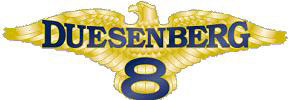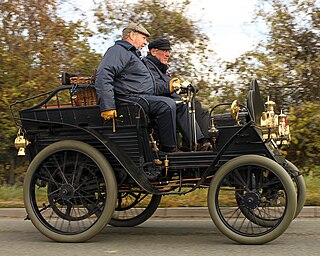
A four-strokeengine is an internal combustion (IC) engine in which the piston completes four separate strokes while turning the crankshaft. A stroke refers to the full travel of the piston along the cylinder, in either direction. The four separate strokes are termed:
- Intake: Also known as induction or suction. This stroke of the piston begins at top dead center (T.D.C.) and ends at bottom dead center (B.D.C.). In this stroke the intake valve must be in the open position while the piston pulls an air-fuel mixture into the cylinder by producing a partial vacuum in the cylinder through its downward motion.
- Compression: This stroke begins at B.D.C, or just at the end of the suction stroke, and ends at T.D.C. In this stroke the piston compresses the air-fuel mixture in preparation for ignition during the power stroke (below). Both the intake and exhaust valves are closed during this stage.
- Combustion: Also known as power or ignition. This is the start of the second revolution of the four stroke cycle. At this point the crankshaft has completed a full 360 degree revolution. While the piston is at T.D.C. the compressed air-fuel mixture is ignited by a spark plug or by heat generated by high compression, forcefully returning the piston to B.D.C. This stroke produces mechanical work from the engine to turn the crankshaft.
- Exhaust: Also known as outlet. During the exhaust stroke, the piston, once again, returns from B.D.C. to T.D.C. while the exhaust valve is open. This action expels the spent air-fuel mixture through the exhaust port.

In a piston engine, either a timing belt or timing chain or set of timing gears is a perishable component used to synchronize the rotation of the crankshaft and the camshaft. This synchronisation ensures that the engine's valves open and close at the correct times in relation to the position of the pistons.

Duesenberg Automobile & Motors Company, Inc. was an American racing and luxury automobile manufacturer founded in Indianapolis, Indiana, by brothers Fred and August Duesenberg in 1920. The company is known for popularizing the straight-eight engine and four-wheel hydraulic brakes. A Duesenberg car was the first American car to win a Grand Prix race, winning the 1921 French Grand Prix. Duesenbergs won the Indianapolis 500 in 1922, 1924, 1925 and 1927. Transportation executive Errett Lobban Cord acquired the Duesenberg corporation in 1926. The company was sold and dissolved in 1937.

An overhead camshaft (OHC) engine is a piston engine in which the camshaft is located in the cylinder head above the combustion chamber. This contrasts with earlier overhead valve engines (OHV), where the camshaft is located below the combustion chamber in the engine block.

A flathead engine, also known as a sidevalve engine or valve-in-block engine, is an internal combustion engine with its poppet valves contained within the engine block, instead of in the cylinder head, as in an overhead valve engine.

The Stutz Motor Car Company was an American producer of high-end sports and luxury cars based in Indianapolis, Indiana. Production began in 1911 and ended in 1935.

The Mors automobile factory was an early French car manufacturer. It was one of the first to take part in automobile racing, beginning in 1897, due to the belief of the company founder, Émile Mors, in racing's technical and promotional benefits. By the turn of the century, automobile racing had become largely a contest between Mors and Panhard et Levassor.

A Corliss steam engine is a steam engine, fitted with rotary valves and with variable valve timing patented in 1849, invented by and named after the US engineer George Henry Corliss of Providence, Rhode Island.

The Doble steam car was an American steam car maker from 1909 to 1931. Its latter models of steam car, with fast-firing boiler and electric start, were considered the pinnacle of steam car development. The term "Doble steam car" comprises any of several makes of steam-powered automobile in the early 20th century, including Doble Detroit, Doble Steam Car, and Doble Automobile, severally called a "Doble" because of their founding by Abner Doble.
Corwin Manufacturing Company was a pioneer brass era American automobile company based in Peabody, Massachusetts.

The Buckeye gasoline buggy, also known as the Lambert gasoline buggy, was an 1891 gasoline automobile, the first made in the United States. It was also the first automobile made available for sale in the United States. It was initially a three-wheel horseless carriage, propelled by an internal combustion gasoline engine; it was later developed into a four-wheel automobile with a gearless transmission, and mass-produced during the first part of the twentieth century. The platform was later expanded into a line of trucks and fire engines.

The Menasco Motors Company was an American aircraft engine and component manufacturer.

An internal combustion engine is a heat engine in which the combustion of a fuel occurs with an oxidizer in a combustion chamber that is an integral part of the working fluid flow circuit. In an internal combustion engine, the expansion of the high-temperature and high-pressure gases produced by combustion applies direct force to some component of the engine. The force is typically applied to pistons, turbine blades, a rotor, or a nozzle. This force moves the component over a distance, transforming chemical energy into kinetic energy which is used to propel, move or power whatever the engine is attached to.
The automotive industry in Massachusetts refers to a period of time from 1893 to 1989 when automobiles were manufactured in the Commonwealth of Massachusetts commercially. In the early years, the state produced more automobiles than Detroit, Michigan. During the 20th century, General Motors and the Ford Motor Company were producing automobiles at the Framingham Assembly and Cambridge Assembly, respectively.
The Series 20 was an automobile produced by Oldsmobile division of General Motors in 1909. When the Oldsmobile Company joined General Motors in 1908, the Series 20 was one of the first examples of platform sharing that became GM's most notable business model, as it was derived from the previously established Buick brand from the Buick Model B. The Series 20 effectively replaced the Model F, also known as the Curved-Dash Oldsmobile, when it was discontinued when GM assumed operations, and was replaced by the 1914 Oldsmobile Model 42 "Baby Olds". It was the entry-level vehicle below the Oldsmobile Model A and the luxury sedan Oldsmobile Model Z. It was the first Oldsmobile to use numbers to identify the product, a tradition that would last until the company concluded operations in 2004.
The Welch Motor Company was an American automobile company headquartered in Chelsea, Michigan. It began in 1901 and continued production of luxury vehicles until 1911 when it merged with General Motors.
The Model 42 was an entry-level four seat passenger car produced by GM's Oldsmobile Division in 1914. It was offered as a replacement to the Oldsmobile Curved Dash runabout when it was discontinued in 1908, and was the junior platform to the Oldsmobile Six introduced in 1913. GM had acquired Elmore Manufacturing Company, Oldsmobile and Oakland Motor Car Company in 1908 and Cartercar and Rainier Motor Car Company in 1909 as their entry-level models, and Oldsmobile products were being repositioned in their new hierarchy as GM began to consolidate operations after William Durant had left.
The Series 22 Special was a four-seat passenger car produced by the Oldsmobile Division of GM in 1910 and 1911. It was the first car engineered by Oldsmobile after it became a division of GM and began sharing a platform with the Buick Model 10. It became the entry-level model for Oldsmobile, replacing the discontinued 1909 Model 20 and the 1909 Model D, while Oakland Motor Car Company became GM's entry level brand as Chevrolet didn't join GM until 1917.

Reliance Worldwide Corporation Limited is an Australian-owned publicly listed company which designs, manufactures and supplies water flow and control products. It is the world's largest manufacturer of PTC behind the wall plumbing fittings. The company operates in Australia, New Zealand, Canada, the United States, Spain, France, Italy, India and the United Kingdom. It is administered from its head office in Melbourne, Australia. It is 109th on the S&P/ASX list of top 200 companies.














